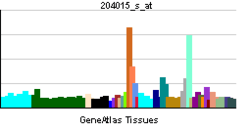DUSP4
Dual specificity protein phosphatase 4 is an enzyme that in humans is encoded by the DUSP4 gene.[1][2][3]
The protein encoded by this gene is a member of the dual specificity protein phosphatase subfamily. These phosphatases inactivate their target kinases by dephosphorylating both the phosphoserine/threonine and phosphotyrosine residues. They negatively regulate members of the mitogen-activated protein (MAP) kinase superfamily (MAPK/ERK, SAPK/JNK, p38), which are associated with cellular proliferation and differentiation. Different members of the family of dual specificity phosphatases show distinct substrate specificities for various MAP kinases, different tissue distribution and subcellular localization, and different modes of inducibility of their expression by extracellular stimuli. This gene product inactivates ERK1, ERK2 and JNK, is expressed in a variety of tissues, and is localized in the nucleus. Two alternatively spliced transcript variants, encoding distinct isoforms, have been observed for this gene. In addition, multiple polyadenylation sites have been reported.[3]
In melanocytic cells DUSP4 gene expression may be regulated by MITF.[4]
References
- ↑ Guan KL, Butch E (May 1995). "Isolation and characterization of a novel dual specific phosphatase, HVH2, which selectively dephosphorylates the mitogen-activated protein kinase". J Biol Chem 270 (13): 7197–203. doi:10.1074/jbc.270.13.7197. PMID 7535768.
- ↑ Smith A, Price C, Cullen M, Muda M, King A, Ozanne B, Arkinstall S, Ashworth A (Sep 1997). "Chromosomal localization of three human dual specificity phosphatase genes (DUSP4, DUSP6, and DUSP7)". Genomics 42 (3): 524–7. doi:10.1006/geno.1997.4756. PMID 9205128.
- ↑ 3.0 3.1 "Entrez Gene: DUSP4 dual specificity phosphatase 4".
- ↑ Hoek KS, Schlegel NC, Eichhoff OM et al. (2008). "Novel MITF targets identified using a two-step DNA microarray strategy". Pigment Cell Melanoma Res. 21 (6): 665–76. doi:10.1111/j.1755-148X.2008.00505.x. PMID 19067971.
Further reading
- King AG, Ozanne BW, Smythe C, Ashworth A (1996). "Isolation and characterisation of a uniquely regulated threonine, tyrosine phosphatase (TYP 1) which inactivates ERK2 and p54jnk.". Oncogene 11 (12): 2553–63. PMID 8545112.
- Chu Y, Solski PA, Khosravi-Far R et al. (1996). "The mitogen-activated protein kinase phosphatases PAC1, MKP-1, and MKP-2 have unique substrate specificities and reduced activity in vivo toward the ERK2 sevenmaker mutation.". J. Biol. Chem. 271 (11): 6497–501. doi:10.1074/jbc.271.11.6497. PMID 8626452.
- Bonaldo MF, Lennon G, Soares MB (1997). "Normalization and subtraction: two approaches to facilitate gene discovery.". Genome Res. 6 (9): 791–806. doi:10.1101/gr.6.9.791. PMID 8889548.
- Husi H, Ward MA, Choudhary JS et al. (2000). "Proteomic analysis of NMDA receptor-adhesion protein signaling complexes.". Nat. Neurosci. 3 (7): 661–9. doi:10.1038/76615. PMID 10862698.
- Chen P, Hutter D, Yang X et al. (2001). "Discordance between the binding affinity of mitogen-activated protein kinase subfamily members for MAP kinase phosphatase-2 and their ability to activate the phosphatase catalytically.". J. Biol. Chem. 276 (31): 29440–9. doi:10.1074/jbc.M103463200. PMID 11387337.
- Strausberg RL, Feingold EA, Grouse LH et al. (2003). "Generation and initial analysis of more than 15,000 full-length human and mouse cDNA sequences.". Proc. Natl. Acad. Sci. U.S.A. 99 (26): 16899–903. doi:10.1073/pnas.242603899. PMC 139241. PMID 12477932.
- Gerhard DS, Wagner L, Feingold EA et al. (2004). "The status, quality, and expansion of the NIH full-length cDNA project: the Mammalian Gene Collection (MGC).". Genome Res. 14 (10B): 2121–7. doi:10.1101/gr.2596504. PMC 528928. PMID 15489334.
- Cadalbert L, Sloss CM, Cameron P, Plevin R (2005). "Conditional expression of MAP kinase phosphatase-2 protects against genotoxic stress-induced apoptosis by binding and selective dephosphorylation of nuclear activated c-jun N-terminal kinase.". Cell. Signal. 17 (10): 1254–64. doi:10.1016/j.cellsig.2005.01.003. PMID 16038800.
- Rual JF, Venkatesan K, Hao T et al. (2005). "Towards a proteome-scale map of the human protein-protein interaction network.". Nature 437 (7062): 1173–8. doi:10.1038/nature04209. PMID 16189514.
- Tresini M, Lorenzini A, Torres C, Cristofalo VJ (2007). "Modulation of replicative senescence of diploid human cells by nuclear ERK signaling.". J. Biol. Chem. 282 (6): 4136–51. doi:10.1074/jbc.M604955200. PMID 17145763.
- Wang J, Shen WH, Jin YJ et al. (2007). "A molecular link between E2F-1 and the MAPK cascade.". J. Biol. Chem. 282 (25): 18521–31. doi:10.1074/jbc.M610538200. PMID 17452331.
| |||||||||||||||||||||||||||||||

